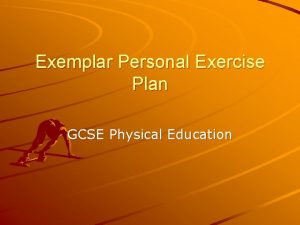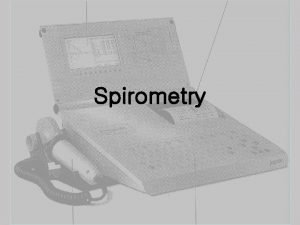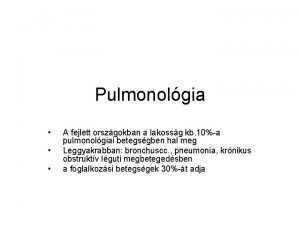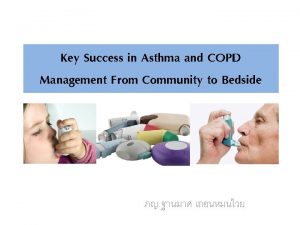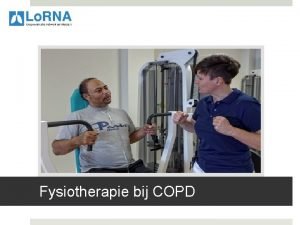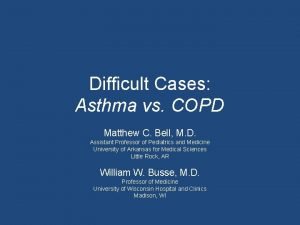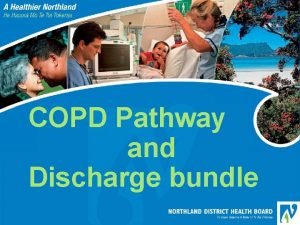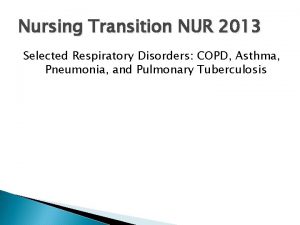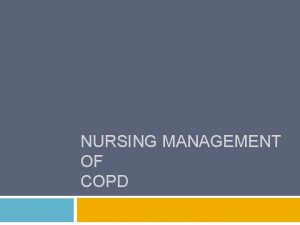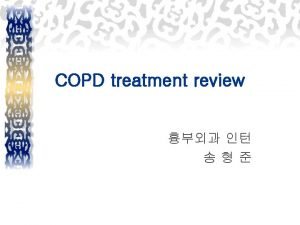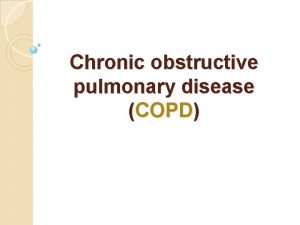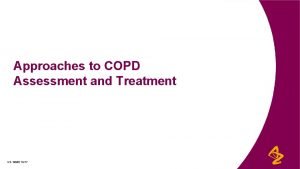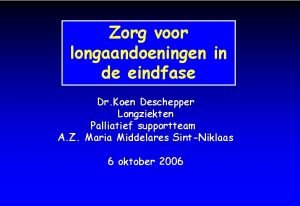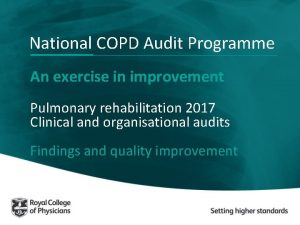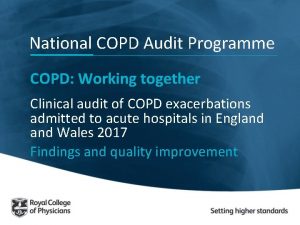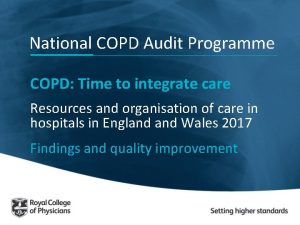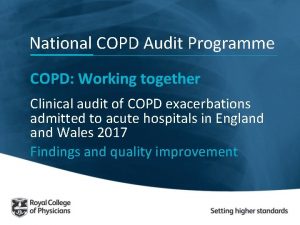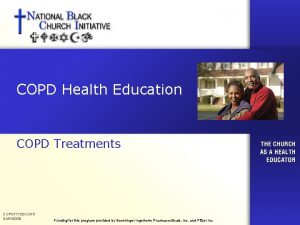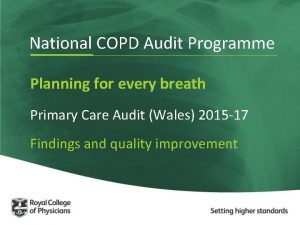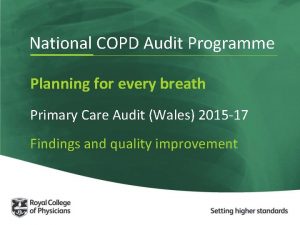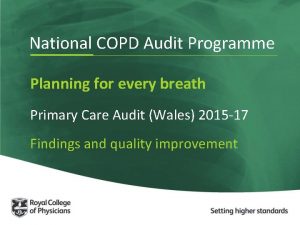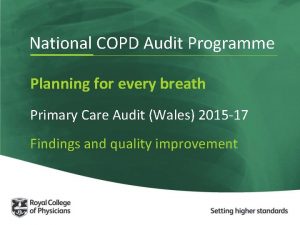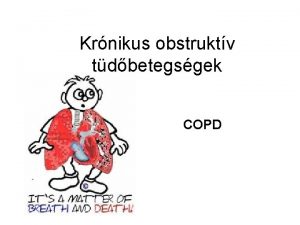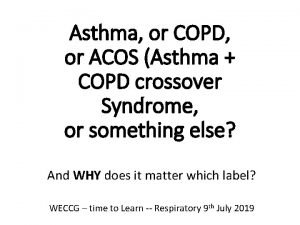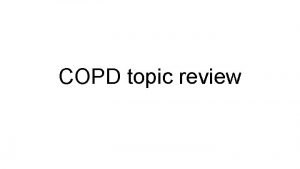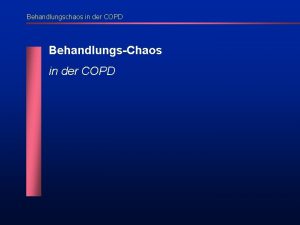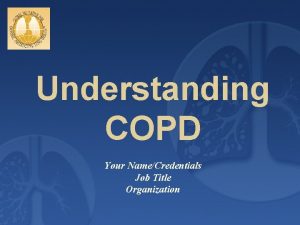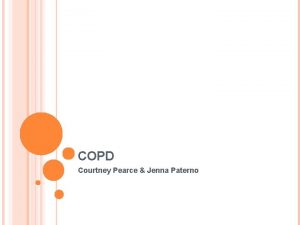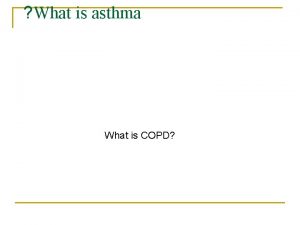National COPD Audit Programme An exercise in improvement

























- Slides: 25

National COPD Audit Programme An exercise in improvement Pulmonary rehabilitation 2017 Clinical and organisational audits Findings and quality improvement

The audit programme partnership Working in strategic partnership: Supported by: Commissioned by:

Report overview • Combined results from clinical and organisational snapshot audits • Including data from consenting patients and registered services from England Wales for the early 2017 audit period Participation

Key findings and recommendations

Access to PR Key findings The median waiting time between referral receipt and PR enrolment overall:

Access to PR Key findings Waiting times are longer for cohort than rolling programmes: Cohort programmes Rolling programmes Percentage of patients starting PR within 90 days is higher in rolling than cohort programmes: Cohort programmes 52% Rolling programmes 66%

Access to PR Key findings Whilst the majority of services accepted patients with conditions other than COPD (eg asthma, lung cancer, heart failure), 5% do not. 2017 2015 8% 19 81% 92% of services accept patients with more severe disability (MRC grade 5), compared to 81% in 2015.

Access to PR National QI priority Reduce waiting times Services should set an achievement target 85% enrolment of those referred for PR within 90 days. How this priority was derived BTS Quality Standard 1 bᵃ People referred for PR should be enrolled within 3 months of service receipt of referral. Tips on how to achieve this Services that solely run cohort programmes and struggle with waiting times: • Consider changing to a rolling design (or to a combination of the two) to deliver this objective.

Quality of PR services Key findings 68% of patients do not complete a recommended practice exercise test * 6 MWT = six minute walk test 10% of services did not offer individually prescribed aerobic or resistance training

Quality of PR services Key findings 2015 2017 27% 73% 15% 84% of services (67% 2015) have a standard operating procedure for local policies 85% 27% of patients had an assessment of muscle strength at baseline in 2017, a considerable improvement from 15% in the 2015 audit Spirometry was reported for 60% of patients BMI was reported for 70% of patients

Quality of PR services National QI priority Exercise assessments should be performed to recommended technical standards Including practice walks and lengths of walking courses How this priority was derived 2015 audit dataᵃ suggests PR outcomes were better in services that undertook practice walks (17% more likely to complete PR). Tips on how to achieve this Space limitations may restrict walking course lengths for the 6 MWT. 30 m • Where this is the case, consider switching to the ISWT which requires only a 10 m course. 10 m Guidance and standards ᵇ exist for each test, you might find it useful to use these in your planning.

Outcomes of treatment Key findings There was no significant difference in outcome between patients enrolled on cohort or rolling programmes. 68% Clinical outcomes of 58% 56% 54% patients who completed 2017 treatment were excellent ISWT 6 MWT SGRQ CAT (similar proportions met 70% 61% 57% 52% the MCID or surpassed it 2015 than did so in 2015). 57% CRQ 57%

Outcomes of treatment National QI priority Increase completion rates Following PR assessment, patient completion rates should be 70% or more How this priority was derived The 2015 PR outcomes reportᵃ found that PR completion was associated with lower hospital admission rates Tips on how to achieve this • Review completion rates, to identify non-completion factors • Develop systems to identify patients at risk of exacerbation and hospital admission • Implement local strategies with specialist and community COPD teams to improve: • Diagnosis, the optimisation of drug treatment, management of co-morbidities, and the promotion of smoking cessation and winter vaccination

And so, what next?

Quality improvement Using quality improvement methodology to plan a change (SMART) Look for areas where you can realistically make improvements. S • Specific Decide on an aim, this should be SMART. M • Measurable A • Achievable R • Realistic T • Time bound Build a team and understand your stakeholders. Meet with your team regularly to performance manage yourselves, and have clear responsibilities. Plan how you will achieve your aim.

Quality improvement Defining your overall aim (driver diagrams) To decide what to start on for your overall improvement aim, you may find it helpful to use a driver diagram. The Institute for Healthcare Improvement has a helpful guide on how to use them http: //www. ihi. org/resources/Pages/Tools/Driver-Diagram. aspx Aim Primary drivers Secondary drivers

Driver diagram example Aim Primary drivers Referrer and patient awareness of PR To increase the number of eligible patients being referred for and completing PR Secondary drivers • Identify patients in primary and acute care who are eligible for PR • Provide clear information on benefits of PR for referrers • Provide clear information for patients about PR • Enhance use of discharge bundles that include PR referral Easy to navigate referral pathways for PR • Develop system prompts to remind users to refer eligible patients • Embed evidence or quality standards in prompts • Streamline referral forms to remove unnecessary information and speed the process Ease of patient access to PR services • Ensure patients are assessed and enrolled within 3 months of referral • Ensure sites are accessible by patient transport • Ensure exercise prescription is individually tailored • Ensure patient access is highlighted in accreditation metrics Use audit data feedback to drive referrals • Real-time feedback of referral rates to referrers • Real-time feedback of clinical outcomes and drop-out rates to PR programmes • Develop commissioner incentives linked to referral and uptake rates to drive up referrals

Quality improvement A model for improvement To plan your change it is important to regularly measure and study your activity using: Model for improvement Aim Measure Change What are we trying to accomplish? How will I know that a change is an improvement? What changes can we make that will result in improvement? Rapid cycle improvement Act Plan Study Do

Quality improvement The PDSA cycle • • • What changes are to be made? Next cycle? Complete the analysis of the data Compare data to predictions Summarise what was learned • • Act Plan Study Do • • Objective Questions and predictions (why) Plan to carry out the cycle (who, what, where, when) Carry out the plan Document problems and unexpected observations Begin analysis of the data

Quality improvement The PDSA cycle example: non completion by patients ACT: Identify what still needs to change to improve what you will do next (Next PDSA cycle) STUDY: Analyse data to see if the rate has improved. Plot the change over time and summarise what you have learned. Act Plan Study Do PLAN: Would changes to the patient information sheets help with non completion rates? DO: Adapt the paperwork and information sheets according to patient feedback, making it more informative and easier to understand.

Quality improvement The PDSA cycle example: non referral by GPs ACT: Identify what still needs to change to improve what you will do next (Next PDSA cycle) STUDY: Have your referral rates gone up? Analyse data to see if the rate has. Plot the change over time and summarise what you have learned. Act Plan Study Do PLAN: How many patients would you expect to see referred from your local GP surgeries? DO: Hold awareness raising sessions with GP surgeries in the local area, to discuss it further with GPs and surgery staff.

Quality improvement Case study Quality improvement case study: Breathing. Space, a pulmonary rehabilitation service in Rotherham, describe a QI project performed locally to increase patient completion. … to reduce drop out rates [they looked at] providing patients, their families and carers with clear, comprehensive and consistent communication. 80% of patients rated the [new] leaflet as ‘useful’ or ‘very useful’. 85% of health and care professionals rated it … a useful tool to issue to patients when introducing … PR.

Useful quality improvement resources Sharing learning Respiratory Futures have a PR page http: //www. respiratoryfutures. org. uk/programmes/pulmonaryrehabilitation/ and forum http: //www. respiratoryfutures. org. uk/pulmonaryrehabforum The British Thoracic Society page has useful resources and signposts https: //www. britthoracic. org. uk/standards-ofcare/quality-improvement/

Useful quality improvement resources Accreditation Check out the new website for the Pulmonary Rehabilitation Accreditation scheme to read more about the scheme and how to apply http: //www. prsas. org/

National COPD Audit Programme pulmrehab@rcplondon. ac. uk 020 3075 1526 www. rcplondon. ac. uk/COPD
 Stroke sentinel national audit programme
Stroke sentinel national audit programme Copd national action plan
Copd national action plan Personal exercise program
Personal exercise program Personal exercise programme
Personal exercise programme Usap audit
Usap audit Ipassbaton
Ipassbaton Spirometry
Spirometry Emphysema
Emphysema Niv modes and settings
Niv modes and settings Cat score copd
Cat score copd Blue and white inhaler
Blue and white inhaler Tiêu chuẩn anthonisen
Tiêu chuẩn anthonisen Gina guidelines
Gina guidelines Non pharmacological treatment for copd
Non pharmacological treatment for copd Conditietraining amsterdam oost
Conditietraining amsterdam oost Asthma vs copd spirometry
Asthma vs copd spirometry Lets be copd
Lets be copd Concept map neuman systems model
Concept map neuman systems model Chronic bronchitis
Chronic bronchitis Copd exacerbation nursing management
Copd exacerbation nursing management Copd v/q mismatch
Copd v/q mismatch Bitemporal wasting in copd
Bitemporal wasting in copd Copd exacerbation nursing management
Copd exacerbation nursing management Copd abcd assessment
Copd abcd assessment Pathogenesis of copd
Pathogenesis of copd Exacerbatie copd
Exacerbatie copd


